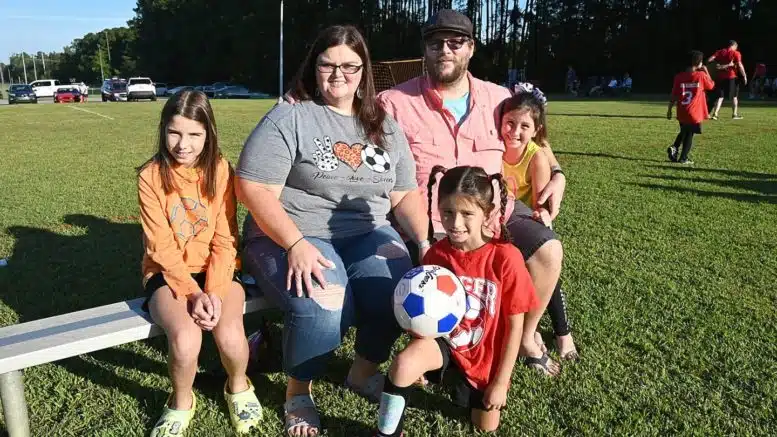By Rachel Baldauf
Amanda Price and her husband were finally in the process of adopting their three daughters in 2022. The couple had fostered the girls for four years and had planned to adopt them in 2020, but the COVID-19 pandemic caused delays.
The wait was hard on the biological sisters, who are now 6, 10 and 11. The older girls struggled with memories of being shuffled around the foster care system. The oldest lived in three different homes before landing with the Prices. At school, the middle child was teased for having a different last name than her parents. “They’ve been through so much in their short years,” Price said.
Finding mental health specialists near the Robeson County town of Orrum where they live was challenging. By 2022, the girls had already changed therapists three times when their providers relocated.
The situations weren’t ideal anyway, because the therapists were better suited to treat adults. So the Prices were ecstatic when they found a provider who specializes in children. They didn’t even mind the 40-minute drive to the office.
A year later, however, they got the dreaded news: That provider was also leaving the area.
“It can be sad for the girls because they really do get close,” said Price, 42. “I’ve seen my girls cry because their therapist was leaving. … It was just another loss for them.”
Like much of rural North Carolina, the southeastern part of the state suffers from a severe shortage of mental health care providers. Columbus, Bladen and Scotland counties don’t have any children’s psychiatrists, according to the American Academy of Child & Adolescent Psychiatry.
The need for more specialists has been especially apparent amid a children’s mental health crisis that experts say is driven by social and academic stressors that were exacerbated during the COVID-19 pandemic. More than one in five high school students in North Carolina said they have seriously considered attempting suicide, according to a report released this year by the nonprofit group NC Child.
More resources are especially crucial for children in the foster care system, experts say. A 2003 study by Casey Family Programs showed that former foster care youth experienced post-traumatic stress disorder at a rate nearly five times higher than the general population. They also experienced other mental health conditions like depression, anxiety and drug dependence at increased rates.
Children in foster care are likely to experience traumatic events early in life, including poverty, displacement and abuse. Being exposed to numerous adverse childhood experiences – often called ACEs – puts children at risk of negative outcomes in adulthood, including mental health struggles and substance abuse, said Barbara Hallisey, chief of clinical programs at Eastpointe, which manages mental health care in several North Carolina counties.
“It’s like a strike against you,” Hallisey said.
Children in foster care are likely to have trauma even if they don’t experience abuse, said Donna Yalch, chief of community-based services at Boys & Girls Homes of North Carolina in Lake Waccamaw. “When a child is taken from their parents to be put into foster care, they already have one trauma, and that’s being removed from their family,” she said.
More children in foster care
Most local counties have seen significant increases in the number of children in foster care. In Columbus County, the number more than doubled between 2018 and 2022, from 66 to 135, according to Algernon W. McKenzie, director of the county’s Department of Social Services. By the end of August this year, 112 children in the county were in foster care.
Robeson County has 368 children in foster care, officials say. Durham County, where the population is more than twice as large, had 297 children in foster care in June.
The growing mental health crisis among young people, including those in foster care, often means lengthy stays in emergency rooms or DSS offices. During the first three months of 2023, an average of half the children who received Medicaid through Eastpointe and Trillium and were in such “inappropriate crisis settings” were under DSS supervision, data shows.
Eastpointe and Trillium are care management organizations that serve many eastern North Carolina counties, including Bladen, Columbus, Robeson and Scotland.
Experts attribute much of the increase in children in foster care to the opioid epidemic that has shattered local communities. Since last year, more than half of all children who entered foster care in Bladen, Columbus and Robeson counties did so because at least one parent was misusing drugs, NCDHHS data shows. In Robeson, the figure exceeded 74%.
The strain on the foster care system is exacerbated by a shortage of foster care families. From 2021 to 2022, the number of licensed foster care homes statewide dropped by nearly 25%, federal data shows.
“I’ve had people that I’ve talked with, and they’re like, ‘You know, I can barely afford to feed my own family. How can I add another mouth to feed?’”
Carrie Decker
The COVID-19 pandemic worsened the problem, said Carrie Decker, the foster home licensing social work supervisor for the Boys & Girls Homes of North Carolina. Decker runs regular training courses for aspiring foster care parents. Before the pandemic, 15 families regularly attended – the maximum under state regulations. Post-COVID, classes often have fewer than five people.
The pandemic made many potential foster care parents afraid of health risks, and inflation has increased the financial burden of fostering, Decker said. “I’ve had people that I’ve talked with, and they’re like, ‘You know, I can barely afford to feed my own family,’” she said. “‘How can I add another mouth to feed?’”
Monthly stipends for foster care parents in North Carolina were raised more than 15% in July through the passage of Senate Bill 20, a controversial measure that restricts abortion access. Foster care parents statewide now receive between $702 and $810 a month per foster child, depending on the age of the child.
In the Border Belt region of Bladen, Columbus, Robeson and Scotland counties, where more than 20% of residents live in poverty, the stipend often doesn’t cover expenses. “It’s not enough to feed and clothe them for an entire month,” Decker said.
Some people say the state should better prioritize placing children with family members or friends instead of foster families. But that too can pose financial challenges.
Denise Shepherd cares for her 18-year-old grandson and three other children, ages 8, 13 and 14, who are not related to her. The children’s parents signed over custody to Shepherd to prevent the kids from entering the foster care system. Because she’s not a licensed foster parent, she doesn’t get financial support from DSS.
Shepherd, 66, said she has had to use a credit card to pay for food for the past four months. “Groceries are a challenge,” she said. “I’ve got three teenagers here, and the 8-year-old can eat almost as much as they can.”
Shepherd said she struggled to afford clothes for the youngest child ahead of summer camp. “That was unacceptable. He’s not going to look like a throwaway child,” she said. “For his self esteem, and for what he needs, he needs to look good.”
Accessing mental health care for children can also be expensive. Decker said local foster families often travel at least an hour to Wilmington or Fayetteville for therapy sessions.
For many families, traveling means taking time off work. “We’ve had foster parents say, ‘If I ask for one more day off, I’m gonna lose my job,’” Decker said.
Identifying those in need
Decker said the lack of providers who accept Medicaid poses a particular problem for children in foster care. In North Carolina, all foster children must be enrolled in Medicaid even if their foster parents have private insurance.
“If a medical practice does not accept Medicaid, that foster child can’t go there,” Decker said.
The Boys & Girls Homes of North Carolina offers therapeutic services to some children living in its licensed homes, but Decker said hiring providers is a constant struggle. “As a nonprofit agency,” she said, “we can’t offer a competitive salary.”
Sign up for our Newsletter
“*” indicates required fields
Despite the many barriers to care for foster children, Hallisey said she’s hopeful that new solutions can help. The COVID-19 pandemic led to an increase in virtual mental health care access. For people living in rural areas, virtual appointments mean they no longer have to drive long distances for care.
“I think that has been one of the barriers that has improved with COVID,” Hallisey said. “You know, good things come out of bad things all the time.”
Hallisey is also excited about new programs that allow students to access mental health care at school.
In August, UNC Health announced a partnership with Bladen County Schools that will place four in-person therapists at schools throughout the district. “Virtual care centers” on campuses will also provide access to telehealth appointments with specialists and psychiatrists.
For foster children, Hallisey said early identification of mental health issues is key. Eastpointe currently holds a daily 30-minute phone call with local DSS offices to identify particular children who are struggling and need extra care, Hallisey said.
“Early identification and early encouragement to access services really makes a difference,” she said.
“I want to see if they can get some of their innocence back.”
Amanda Price
Amanda Price’s daughters haven’t been back to therapy since their last provider moved away. Working to gain the trust of new therapists became emotionally taxing for the girls, Price said.
“They go talk to the therapist and tell them all this stuff. Then all of a sudden, this one is leaving, and they’ve got to earn the trust of somebody else,” Price said. “They’re not just gonna start talking to somebody until they start trusting them.”
This year, the Prices decided to homeschool their daughters. The teasing that the girls experienced at school was a factor in their decision.
“I don’t want them to have to grow up any faster than they already have,” Price said.
Today, Price’s daughters spend their days going to soccer games, singing at church and playing with their dog Cookie. They might return to therapy in the future. But for now, Price said they need time to settle in without having to worry about appointments and paperwork.
“I want to see if they can get some of their innocence back,” Price said.














